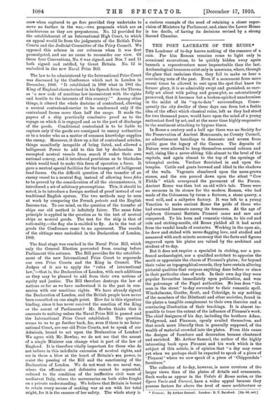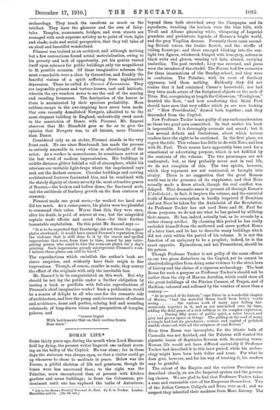THE POET LAUREATE OF THE RUINS.* THE Londoner of to-day
knows nothing of the romance of a, ruin. For him Roman remains come to light only in occasional excavations, to be quickly hidden away again beneath a superstructure more impenetrable than the last. Archaeological treasures exist only in museums, where, through the glass that enshrines them, they fail to make us hear a convincing note of the past. Even if a monument from more recent times be allowed to rest upon the spot that knew its former glory, it is so admirably swept and garnished, so care- fully set about with paling and grass-plot, so ostentatiously preserved, that it becomes but a broken-spirited anachronism in the midst of its " up-to-date " surroundings. Conse- quently the city dweller of these days can form but a feeble idea of the effect which classical ruins, left as they had stood for two thousand years, would have upon the mind of a young enthusiast fired by art, and at the same time highly responsive to the sentiment attaching to bygone times.
In Rome a century and a half ago there was no Society for the Preservation of Ancient Monuments, no County Council, no advertisement hoardings to desecrate and screen from public gaze the legacy of the Caesars. The deposits of Nature were allowed to heap themselves around column and wall, rising like a never-ebbing tide almost to the level of the capitals, and again almost to the top of the openings of triumphal arches. Verdure flourished in and upon the temples. Cattle and goats browsed and idled in the shadows of the walls. Vagrants slumbered upon the moss-grown stones, and the sun poured down upon the silent "Cow Fields" which overspread the pavement of the Forum. Ancient Rome was then but an old wife's tale. There were no sermons in its stones for the modern Roman, who had made of the Colosseum by turns a fortress, a stone quarry, a wool mill, and a saltpetre factory. It was left to a young Venetian to make ancient Rome the pride of those who had swarmed insensate among its treasures. At the age of eighteen Giovanni Battista Piranesi came and saw and conquered. To his keen and romantic vision, to his rod and rule and etching-needle, old Rome yielded all it had saved from the vandal hands of centuries. Working in the open air, he drew and etched with never-flagging love, and studied and measured with such minute accuracy that the facts and figures engraved upon his plates are valued by the architect and student of to-day.
But it does not require a specialist in etching, nor a pro- fessed archaeologist, nor a qualified architect to appraise the merit or appreciate the charm of Piranesi's plates; for beyond their value as topographical records, they have certain alluring pictorial qualities that surpass anything done before or since in their particular class of work. In their own day they were popular favourites immediately upon publication, and won the patronage of the Papal authorities. No less does "the man in the street" to-day surrender to their romantic spell. Winckelmann, Goethe, Scott, and Coleridge, to say nothing of the members of the Dilettanti and other societies, found in the plates a tangible complement to their own theories and a convincing illustration of their teachings. It is almost im- possible to trace the extent of the influence of Piranesi's work. The chief designers of his day, including the brothers Adam, Wedgwood, and Flaxman, openly availed themselves, and that much more liberally than is generally supposed, of the wealth of material crowded into the plates. From this cause the designs of furniture and decoration became chastened and enriched. Mr. Arthur Samuel, the author of the highly interesting book upon Piranesi and his work which is the subject of this article, is of opinion that "a day may come yet when we perhaps shall be expected to speak of a piece of 'Piranesi' where we now speak of a piece of Chippendale furniture."
The collector of to-day, however, is more covetous of the larger views than of the plates of details and ornaments. Such works as appear in the Vedute di Roma series, or the Opere Vane and Careen, have a wider appeal because they possess factors far above the level of mere architecture or
* Piranesi. By Arthur Samuel. London : B. T. Botsford. [128. ed. net.]
archaeology. They touch the emotions as much as the intellect. They have the glamour and the awe of fairy- tales. Temples, monuments, bridges, and even streets are managed with such supreme artistry as to point of view, light and shade, scale and aerial perspective, that they tell tales of an aloof and beautiful wonderland.
Piranesi was trained as an architect, and although nothing
but a few restorations found actual materialisation, owing to his poverty and lack of opportunity, yet his genius vented itself upon schemes for public buildings only too magnificent to fit possible occasion. Of these imaginative schemes the most remarkable were a class by themselves, and frankly the fanciful visions of a spirit suffering from nightmarish depression. These he called Le Careeri d'Invenzione. They
are impossible prisons and torture-houses, vast and intricate, wherein the eye wanders never to see the end of the soaring and receding fastnesses. The fascination of the horror in them is accentuated by their specious probability. More sublime essays in the awe-inspiring have never been made.
Our own recently demolished Newgate, admitted to be the most eloquent building in England, undoubtedly owed much to the association of Dance with Piranesi. Mr. Samuel observes that Mr. Blomfield goes so far as to give the opinion that Newgate was, to all intents, more Piranesi than Dance.
Considered only as an etcher, Piranesi stands in the very front rank. No one since Rembrandt has made the process so entirely amenable to every whim or afterthought of the artist. As a worker in monochrome, he sometimes arrives at the last word of modern impressionism. His buildings in middle distance glitter behind a veil of atmosphere, whilst his interiors are veritable light-traps where the imprisoned rays seek out the darkest corners. Circular buildings and curving architectural features fascinated him, and he combined with the stately dignity of classic severity the most attractive graces of Rococo,--the broken and hollow dome, the fractured arch, and the antithesis of feathery growth on the firm contours of masonry.
Piranesi made one great error,--he worked too hard and did too much. As a consequence, his plates were too plentiful to command their value. Worse than this, they were once, after his death, in peril of seizure at sea; but the misguided captain made efforts and saved them—for their further lamentable exploitation. On this point Mr. Samuel says :—
" It is to be regretted that Troubridge did not throw the copper plates overboard ; it would have spared Piranesi's reputation from the violence that is still done to it by the coarse and spoiled impressions that were, from time to time, issued by any enter- prising person who eared to hire the worn-out plates for a day's printing. Such impressions grossly misrepresent Piranesi's work. I believe these plates can still be hired."
The reproductions which embellish the author's book are above suspicion, and evidently have their origin in fine impressions. Though, of course, smaller in scale, they convey the effect of the originals with only the inevitable loss.
Mr. Samuel is to be congratulated on this work. But why should he not lay the public under a further obligation by issuing a book or portfolio with full-size reproductions of Piranesi's chief imaginative works ? Such a publication would be a source of delight to all who care for the romantic side of architecture, and love the pomp and circumstance of column and architrave, dome and portico, echoing hall and sounding colonnade, of long-drawn vistas and perspectives of temples, palaces, and
"towers begirt With battlements that on their restless fronts Bear stars."























































 Previous page
Previous page